Continental drifting: Vacation in Oregon
We did a bit of continental drifting ourselves last week when we flew cross country to Oregon for a long overdue vacation. I took the boys for almost daily visits to the tide pools at Otter Rock (a beach between Lincoln City and Newport, Oregon) and was struck by similarities between the geology of the area and that of the Connecticut Valley.
Both this area of the Oregon coast and the Connecticut Valley are comprised of sedimentary and igneous rocks. The sedimentary rocks along the Oregon coast are comparatively younger and more clay-like than Connecticut Valley sandstones. Igneous rocks such as the basalts found along the Oregon coast are also much younger, dating from the Tertiary Period, or approx. 15-20 million years ago. By contrast, the Connecticut Valley's sedimentary strata and igneous basalts are much older, dating from the early Jurassic Period, or as long ago as 200 million years ago.
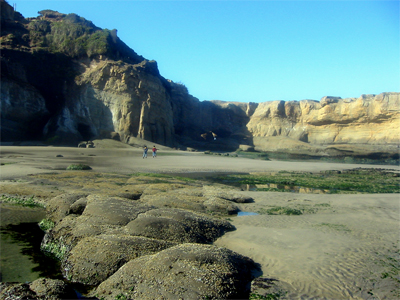
Layers of sedimentary rock, or strata, as well as evidence of subsequent tilting, can be seen in the headlands surrounding Otter Rock. The sunlit spots inside the shadow at the center of the photo are from a large bowl, Devil's Punch Bowl, eroded out of the sediments at the southern end of the beach. The Punch Bowl floods at high tide, with waves crashing well up and even above the top of the headland. It can be entered from beach level and explored at low tide, which is quite exciting after you've seen it from the top, boiling with waves and pounded by the surf.
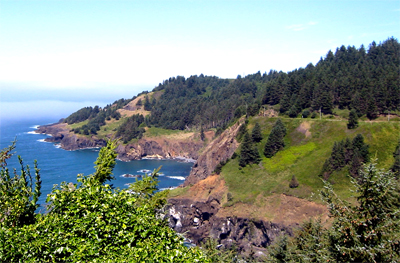
To the north of the Otter Rock area, the headlands are exposures of volcanic rock known as basalt, similar to the basalts found in the Connecticut Valley and its traprock ridges. The columns and blocks are quite dramatic and distinct, even more so that what you see in Connecticut, perhaps because of their younger age. In places large sections of rock can let go all at once, loosing great piles of enormous blocks to build up in piles along the sea.
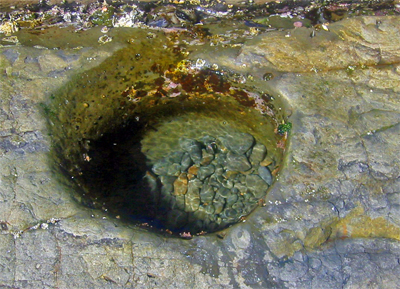
The Pacific is also working to rapidly erode the sedimentary rocks, creating many depressions in rocks in the subtidal and tidal zones. Some, like the nearly cylindrical depression pictured above, take on remarkable shapes (perhaps the result of a former cast or an area of softer or less well cemented sediments being removed at a higher rate).
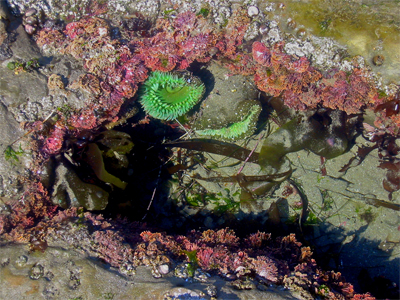
Where these depressions hold water long enough to support colonization, tide pools support wonderful communities of marine plants and animals. These communities can grow to fill tidal pools with anemones, urchins, barnacles, mussels, algae and plants. You find anemones, for instance, lining pools and cracks right up to where they usually hold water at low tide, but no further. The green anemones, purple urchins, ochre and sunflower sea stars and seaweeds are spectacular, and endlessly fascinating.
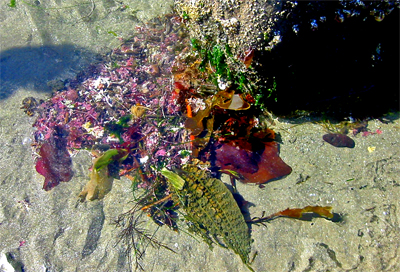
Just a bit further back in the tidal zone we found lots of what we call "sand crabs," or small marine animals known as amphipods that commonly inhabit sandy beaches near the subtidal zone. Amphipods are also common along the Connecticut shore and east coast of the US. The gulls found them as well, and the birds were quite adept at using their bills to dig the sand crabs out of their burrows, peck their heads off, and gobble these morsels down like museum patrons eating shrimp cocktail at the opening of a new exhibition. The boys and I were fascinated to find many shells still wiggling around, literally "like chickens with their heads cut off."
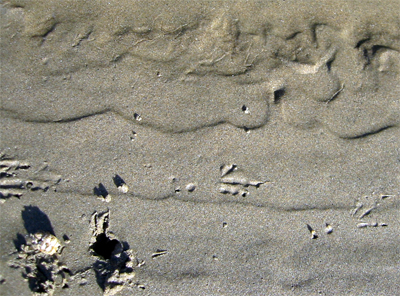
Pictured above are the footprints of one of the marauding gulls. Seen in the lower left hand corner is one of the headless sand crabs beside the hole the bird drilled to extract and eat it. The footprint at center looks very much like the Connecticut Valley dinosaur footprint Grallator, revealing similarities in foot designs shared only by extinct dinosaurs and their modern day survivors, birds.
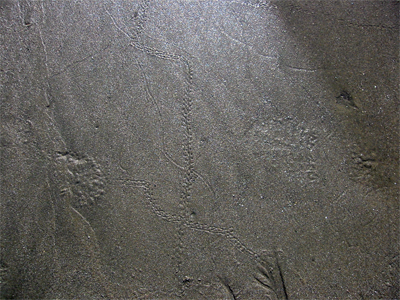
Above is a photo of sand crab or amphipod tracks. The round, "stirred" impression to the left is a place where the amphibod burrowed into the sand and buried itself. It's amazing how fast they can wriggle through wet sand!
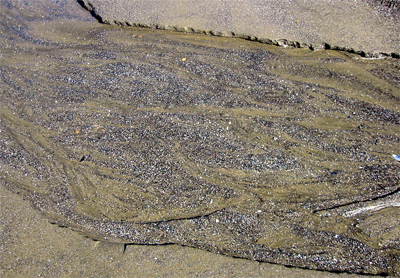
Oregon beaches are typically crossed at least in one place by rivers draining out of the Coast Range mountains, and that spread out where they reach the sand to form wide, shallow streams to the ocean. These streams transport small grained sediments (on a much smaller scale) in a manner similar to the way rivers deposited sediments in large scale alluvial fans such as those found in the Connecticut Valley.
0 Comments:
Post a Comment
<< Home